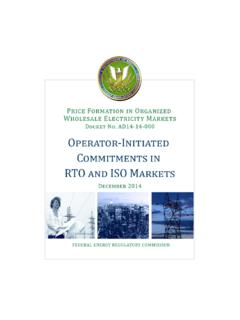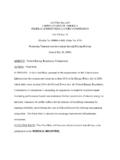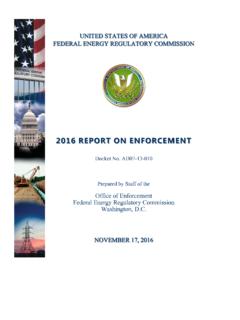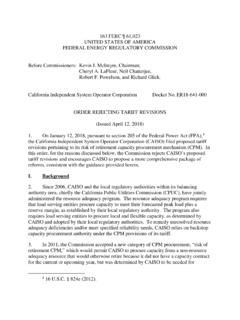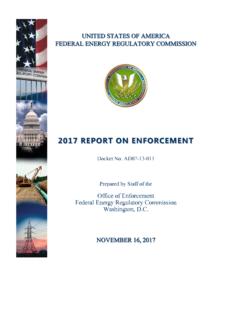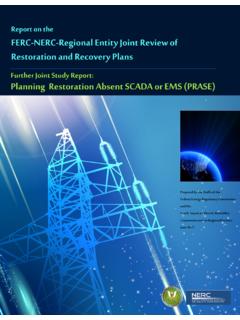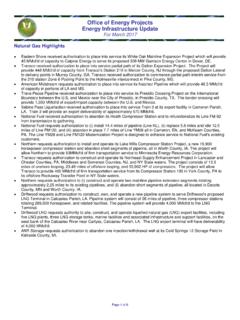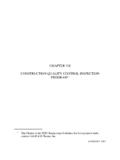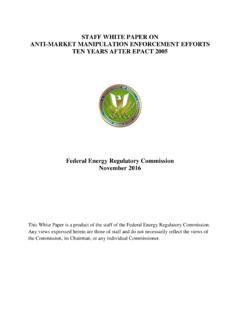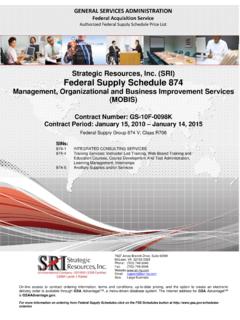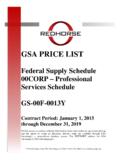Transcription of Reactive Power Staff Report - Federal Energy …
1 Payment for Reactive Power Commission Staff Report AD14-7 April 22, 2014 The opinions and views expressed in this Staff Report do not necessarily represent those of the Federal Energy Regulatory Commission, its Chairman, or individual Commissioners, and are not binding on the Commission. 1 Payment for Reactive Power I. Introduction .. 2 II. Background .. 4 III. Current Methods Used to Pay for Reactive Power Capability .. 8 A. Commission Precedent .. 8 B. OATT Schedule 2 .. 13 IV. Alternative Approaches to Payment for Reactive Power Capability .. 16 A. Potential Improvements to the AEP Methodology .. 17 B. Alternative Cost-Based Approaches to Reactive Power Compensation .. 19 C. Competitive, Market-Based Solicitation of Reactive Power .
2 22 V. Conclusion .. 22 Appendix 1: Technical Characteristics of Generators .. 1 Appendix 2: Cost of Reactive Power Equipment .. 1 Appendix 3: Details of OATT Schedule 2 Rates for Selected Transmission Providers .. 1 2 I. Introduction In Order No. 784, the Commission revised its regulations to foster competition and transparency in ancillary services Among other things, the Commission revised Part 35 of its regulations to reflect reforms to its Avista2 policy governing the sale of certain ancillary services at market-based rates to public utility transmission providers. However, the Commission found that the technical and geographic requirements associated with Reactive Supply and Voltage Control (Schedule 2) and Regulation and Frequency Response (Schedule 3) services precluded reforms to the Avista policy with respect to the sale of those services .
3 Instead, the Commission stated its intention to gather more information regarding the technical, economic and market issues concerning the provision of these services . To that end, Commission Staff will hold a workshop on April 22, 2014, to discuss these issues with interested participants. In advance of this workshop, Staff is releasing this paper to highlight some of the topics to be explored with respect to Schedule 2 service. Staff has examined issues surrounding the provision of Reactive Power several times over the last decade. The Commission established minimum requirements with respect to the provision of Reactive Power by large generators in Order Nos. 2003 and Commission Staff further considered a range of pricing and procurement options for Reactive Power in a Report issued in 2005 (2005 Staff Report ).
4 4 In Order Nos. 20065 and 661,6 the Commission revisited Reactive 1 Third-Party Provision of ancillary services ; Accounting and Financial Reporting for New Electric Storage Technologies, Order No. 784, FERC Stats. & Regs. 31,149 (2013), at P 61. 2 Avista Corp., 87 FERC 61,223, order on reh g, 89 FERC 61,136 (1999) (Avista). 3 See Standardization of Generator Interconnection Agreements and Procedures, Order No. 2003, FERC Stats. & Regs. 31,146 (2003), at P 546, order on reh g, Order No. 2003-A, FERC Stats. & Regs. 31,160, at P 416, order on reh g, Order No. 2003-B, FERC Stats. & Regs. 31,171 (2004), order on reh g, Order No. 2003-C, FERC Stats. & Regs. 31,190 (2005), aff'd sub nom. Nat l Ass n of Regulatory Util.
5 Comm rs v. FERC, 475 1277 ( Cir. 2007), cert. denied, 552 1230 (2008). 4 FERC, Principles for Efficient and Reliable Reactive Power Supply and Consumption, Docket No. AD05-1-000 (2005) (2005 Staff Report ), available at 3 Power issues with respect to small and wind-powered generators, generally concluding that small generators should be subject to the same requirements as large generators, but wind generators should In 2012, Staff held a technical conference to evaluate Reactive Power policies as applied to wind and solar generation, leading to additional, informal outreach by Staff with respect to Reactive Power compensation practices in various To date, the Commission has not required a uniform approach with respect to compensation for Reactive Power .
6 As a result, different payment and cost recovery methods have been adopted in each region. Transmission providers in some regions pay a cost-based payment for Reactive Power capability, while others require Reactive Power capability as part of good utility practice, , without compensation. For transmission providers that do pay for Reactive Power capability, the American Electric Power (AEP) methodology is generally used to compute cost-based Reactive Power capability payments. Although not currently used in any region, competitive solicitations could be implemented to procure and price Reactive Power service. To facilitate that approach, Order No. 784 established parameters for the use of competitive solicitations by public utility transmission providers seeking to acquire ancillary services for purposes of satisfying their Open Access Transmission Tariff (OATT) obligations.
7 Regardless of the procurement mechanism used, alternatives to the AEP methodology could be used to develop rates for Reactive Power , such as a multi-part payment reflecting both the capability and the provision of Reactive Power . In this paper, Staff reviews existing and alternative approaches to Reactive Power compensation in order to facilitate discussion at the April 2014 workshop with respect to the technical, economic and market issues associated with Schedule 2 service. The paper begins with background information regarding Reactive Power , then reviews current 5 Standardization of Small Generator Interconnection Agreements and Procedures, Order No.
8 2006, FERC Stats. & Regs. 31,180, order on reh g, Order No. 2006-A, FERC Stats. & Regs. 31,196 (2005), order granting clarification, Order No. 2006-B, FERC Stats. & Regs. 31,221 (2006). 6 Interconnection for Wind Energy , Order No. 661, FERC Stats. & Regs. 31,186, order on reh g, Order No. 661-A, FERC Stats. & Regs. 31,198 (2005). 7 Order No. 2006, FERC Stats. & Regs. 31,180 at P 387; Order No. 661-A, FERC Stats. & Regs. 31,198 at P 41-46. 8 Notice of Technical Conference, Docket No. AD12-10-000 (Feb. 17, 2012). 4 methods used to pay for Reactive Power before turning to a discussion of alternative approaches for To some degree, the compensation-related issues discussed herein might inform the discussion of technical, economic and market issues associated with Schedule 3 service.
9 A notice of workshop and detailed agenda is being issued concurrently with this paper. Parties are invited to discuss this Report at the technical conference. II. Background Reactive Power is a critical component of operating an alternating current (AC) electricity system, and is required to control system voltage within appropriate ranges for efficient and reliable operation of the transmission system. At times generators or other resources must either supply or consume Reactive Power for the transmission system to maintain voltage levels required to reliably supply electricity from generation to load. In this section, we discuss transmission system needs for Reactive Power , types and sources of Reactive Power from different types of generation and transmission equipment, and the role of Energy storage and demand response in provision of Reactive This background provides context for the discussions on payment for Reactive Power in later sections.
10 Ensuring that Reactive Power is adequate to support transmission service, whether from transmission system elements, generators, load, distribution system elements, Energy storage, or an appropriate mix of these, is one of the transmission planning and operations responsibilities of the transmission planner and operator. Vertically integrated utilities meet Reactive Power needs by placing Power factor requirements on generators and large loads, in addition to planning and operating their transmission and distribution systems to regulate voltages. In organized wholesale markets, the system operator (ISO or RTO) and transmission owners jointly set voltage schedules for both affiliated and independent generators in each transmission owner area, and consider future Reactive Power needs as part of transmission system planning.
